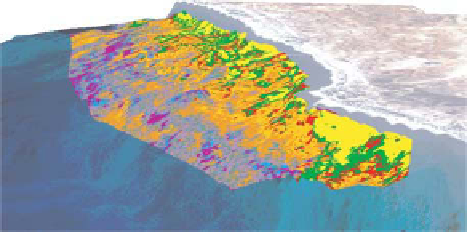Geology Reference
In-Depth Information
Eight bottom types (facies) with a patchy
distribution could be discriminated (Fig. 3).
Landscape components clearly fell into two
biologically and sedimentologically functional
groups. The fi rst group, found only on uncon-
solidated sediment, consisted of sand, seagrass
and shallow macroalgae. The second group,
found only on consolidated sediment, consisted
of hardground, sparse corals, dense corals, dead
corals and algae. The ecological data suggested
that four coral assemblages were resolved on
the image:
•
large but sparse live corals (mostly
Porites
and
faviids) on hardground (magenta in Fig. 3);
sparse, mostly dead
•
Acropora
mixed with live
faviids and
Porites
. (light blue in Fig. 3);
dense and interlocking dead
•
Acropora
(dark
purple in Fig. 3);
sparse, small, live
•
Siderastrea savignyana
on
sandy hardgrounds. (orange in Fig. 3 and not
differentiated from bare hardgrounds).
These coral assemblages form part of a succes-
sional cycle, driven by temperature-related coral
death (Riegl, 1999, 2002; Purkis & Riegl, 2005).
Coral assemblages show a halo-like structure with
patches of dense dead coral surrounded by sparse
live coral and then by hardground with only occa-
sional corals (Fig. 3). The repetitive and most
likely cyclic nature of coral succession strongly
suggests a temporal Markovian property of the
system. Several positive temperature excursions
killed wide areas of mostly
Acropora
. Once killed,
the corals were soon settled by
Chama aspera
bivalves, and then by red algae
Lithophyton
kotschyanum
(Fig. 4). A variety of green and
brown algae also settled on the skeletons, the
Fig. 3.
The classifi ed landscape in the coral biostromal
system and its associated landscapes in the Arabian
Gulf (Jebel Ali). The white line shows the depth cut-off
(8 m), deeper pixels did not carry enough information for
classifi cation and were discarded.
(a)
Coral community dynamics
(b) Taphonomic dynamics
(1) coral is alive
(1) Recruitment onto hardground
(2) Year 1 after death: surficial erosion
by e
ch
inoderms
unconsolidated sediment
unconsolidated sediment
(2) Establishment of community
(3) Year 1-2: settlement by
Chama
as
p
e
r
a
(3) Climax stage with competitive displacement of weaker species
(4) Year 2-4: death of
Chama aspera
,
settlement by coralline algae,
serpulids,
Spondylus
spp.
(4) Bleaching and selective, compensatory mortality
(5) Year 4-6: increased boring by
sponges and bivalves weakens skeleton
(5) Framework breakdown and new recruitment
Fig. 4.
Ecological (a) and taphonomic
(b) dynamics within the coral com-
munities that make up the patches of
coral biostrome in the Jebel Ali land-
scape. Modifi ed from Purkis & Riegl
(2005) where discussed in detail.
(6) Re-establishment of community and lateral spread
(6) Year 6-10: skeleton breaks down
Area of old framework re-establishes
expansion
area















































































































































































































































































































































































































































































































































































































































